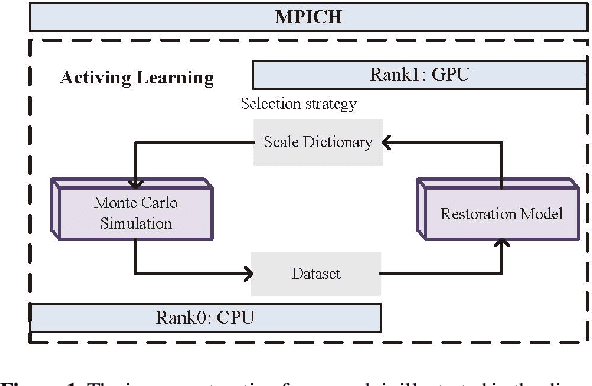Kaifan Ji
Image Restoration with Point Spread Function Regularization and Active Learning
Oct 31, 2023



Abstract:Large-scale astronomical surveys can capture numerous images of celestial objects, including galaxies and nebulae. Analysing and processing these images can reveal intricate internal structures of these objects, allowing researchers to conduct comprehensive studies on their morphology, evolution, and physical properties. However, varying noise levels and point spread functions can hamper the accuracy and efficiency of information extraction from these images. To mitigate these effects, we propose a novel image restoration algorithm that connects a deep learning-based restoration algorithm with a high-fidelity telescope simulator. During the training stage, the simulator generates images with different levels of blur and noise to train the neural network based on the quality of restored images. After training, the neural network can directly restore images obtained by the telescope, as represented by the simulator. We have tested the algorithm using real and simulated observation data and have found that it effectively enhances fine structures in blurry images and increases the quality of observation images. This algorithm can be applied to large-scale sky survey data, such as data obtained by LSST, Euclid, and CSST, to further improve the accuracy and efficiency of information extraction, promoting advances in the field of astronomical research.
High-resolution Solar Image Reconstruction Based on Non-rigid Alignment
Jul 01, 2022



Abstract:Suppressing the interference of atmospheric turbulence and obtaining observation data with a high spatial resolution is an issue to be solved urgently for ground observations. One way to solve this problem is to perform a statistical reconstruction of short-exposure speckle images. Combining the rapidity of Shift-Add and the accuracy of speckle masking, this paper proposes a novel reconstruction algorithm-NASIR (Non-rigid Alignment based Solar Image Reconstruction). NASIR reconstructs the phase of the object image at each frequency by building a computational model between geometric distortion and intensity distribution and reconstructs the modulus of the object image on the aligned speckle images by speckle interferometry. We analyzed the performance of NASIR by using the correlation coefficient, power spectrum, and coefficient of variation of intensity profile (CVoIP) in processing data obtained by the NVST (1m New Vacuum Solar Telescope). The reconstruction experiments and analysis results show that the quality of images reconstructed by NASIR is close to speckle masking when the seeing is good, while NASIR has excellent robustness when the seeing condition becomes worse. Furthermore, NASIR reconstructs the entire field of view in parallel in one go, without phase recursion and block-by-block reconstruction, so its computation time is less than half that of speckle masking. Therefore, we consider NASIR is a robust and high-quality fast reconstruction method that can serve as an effective tool for data filtering and quick look.
A Subpixel Registration Algorithm for Low PSNR Images
Mar 31, 2018


Abstract:This paper presents a fast algorithm for obtaining high-accuracy subpixel translation of low PSNR images. Instead of locating the maximum point on the upsampled images or fitting the peak of correlation surface, the proposed algorithm is based on the measurement of centroid on the cross correlation surface by Modified Moment method. Synthetic images, real solar images and standard testing images with white Gaussian noise added were tested, and the results show that the accuracies of our algorithm are comparable with other subpixel registration techniques and the processing speed is higher. The drawback is also discussed at the end of this paper.
 Add to Chrome
Add to Chrome Add to Firefox
Add to Firefox Add to Edge
Add to Edge